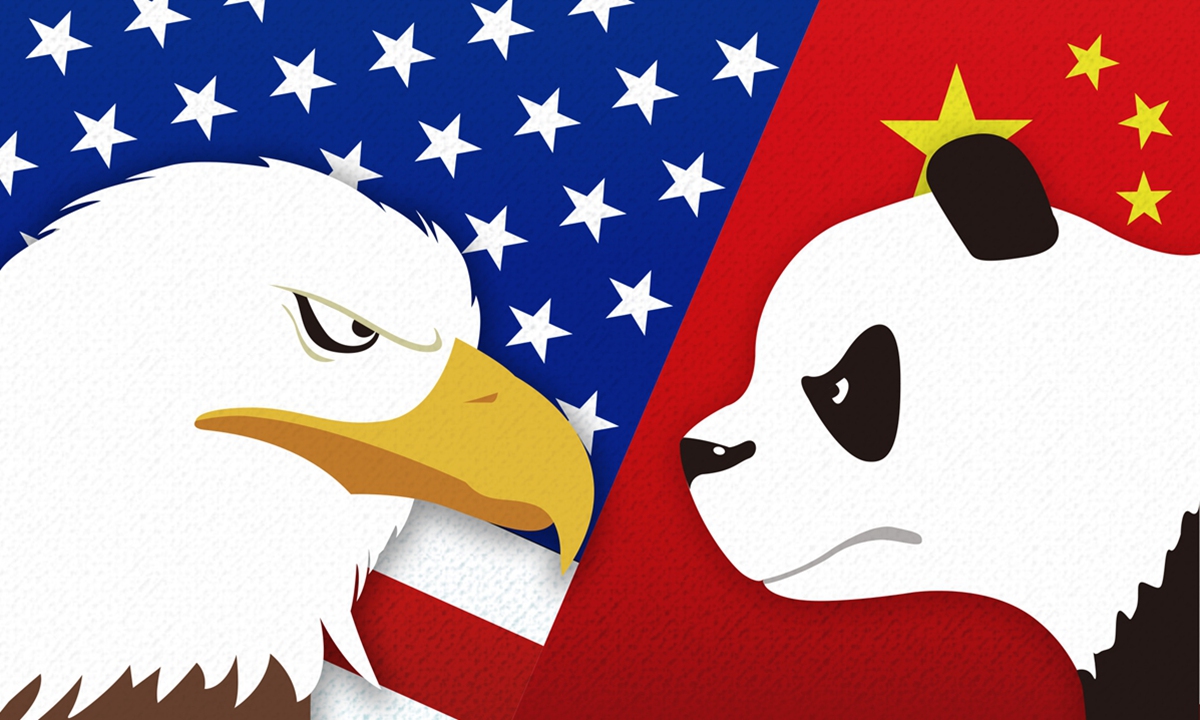US-China Hostility and National Civil Solidarity
The image above accompanies a piece in the Global Times titled, "US irrational hostility toward China a coldly rational ploy". Accordingly, the image depicts a charged face-off of between a bald eagle and panda bear, meant to represent the United States and China respectively. The eagle's brow is sharply furrowed, pupil directed menacingly at its opponent. Its beak is set in a grimace, harsh lines contributing to its severe disposition. Across the border, the normally docile image of a panda is perverted with the black spot over its eye distorted to resemble a knitted brow. The edge of its mouth is drawn down in an angry frown as it glares at the eagle. The two animals are set against a backdrop of the American and Chinese flags, the two countries literally competing for space within the frame. A sharp diagonal line cuts through the tension, separating the two opposing sides. In this struggle, the red, white, and blue of the American flag appear to overpower the red and yellow of the Chinese flag, perhaps a nod to the article's assertion of US aggression.
The basis of this feud draws on Durkheimian ideas of solidarity, as expressed in The Civil Sphere, by Jeffrey Alexander. In this book, Alexander probes how civil solidarity is constructed, asking: what creates the "we-ness" that keeps society together (Alexander 2006:53)? The answer lies in the dichotomous distinctions between good and bad, civil and uncivil. These binary codes are employed to create the illusion of a worthy "we" and an unworthy "other". Certainly, these characterizations do not draw on some objective truth, but emerge from the inner logic of the binary code to posit certain groups as more virtuous than others (Alexander 2006:55). These arbitrary homologies and antipathies are especially relevant to forming national identity and solidarity with one's countrymen: individuals that seek belonging will naturally align themselves with positive characteristics as accepted by the national community, while scorning those on the other side of the symbolic set. It is not only one's motives or even the structure of a nation's institutions that inspire national identity, but also the land itself. As Alexander (2006:196) explains, the concept of territory converts the land into a sacred place, bestowing upon it a primordial quality. As such, those who are of the sacred land are allotted freedom and respect while those who tread foreign soil become incapable of civility. This sense of superiority is exacerbated by myths of founding. For the United States, its claim to power derives from "ancient constitutions of eleventh-century Anglo-Saxons" which have been reified over the course of American history and culture through the esteem of independence and democracy (Alexander 2006:63). This primordial claim to power allows the U.S. to justify its violence and inhumanity for the sake of ushering in freedom as arbiters of morality.
The concepts described above are clearly reflected in the U.S.' modern and historical view of China. In the U.S., the tenets of democracy are considered sacred objects that must be protected. Meanwhile, the ideas that juxtapose democracy and the positive side of the symbolic set constitute the profane realm–evil, immoral things that deserve scorn. It is no surprise, then, that China is appointed as the pinnacle of amoral values to the west. Certainly, its communist government structure sits diametrically opposed to American ideals of individualism. U.S. elites hold deep suspicion of China, considering it a tyrannical bully in Asia that embodies anticivil motives. This has been true since the 19th century when "Yellow Peril" was coined as a derogatory term for Asian immigrants who were accused of stealing righteous Americans' jobs. More recently, these anti-China sentiments came to a head during Trump's presidency, during which he expounded on China's global misconduct and thievery. He spoke at length about the "Chinese Virus", allowing Asian Americans to shoulder responsibility for the spread of COVID-19. Here, Trump drew on the binary code, pointing to the Chinese ethnicity as a profane characteristic to be avoided at all costs. But the othering of China is not only found in the political sphere; indeed, contempt of the Chinese government has bled into cultural narratives and pop culture as well. One need only look to the differential portrayals of China and other east Asian countries to see the preferential treatment of Japan and Korea on the part of the west. While Japanese and Korean culture are considered beautiful, rich, and hyper-advanced, Chinese culture is considered dirty and old-fashioned. Foods and fashion trends that originate in China are rebranded and resold as Japanese or Korean to be viewed more favorably: "manhua" lashes are called "manga" lashes to emulate Japan, while tanghulu (a traditional Chinese snack of candied fruit) is attributed to Korea.
References:
Alexander, Jeffrey C. 2006. The Civil Sphere. New York: Oxford University Press.
Mostoles, Thess. 2020. “An Asian-American Author Talks About Racism in the Pandemic.” The New York Times, June 24.
Rui, Liu. 2022. "China US Illustration." From Global Times. Retrieved May 28, 2024. (https://www.globaltimes.cn/Portals/0/attachment/2021/2021-07-24/68d34166-1324-4540-b1b3-caf67930a0a3.jpeg).


Comments
Post a Comment